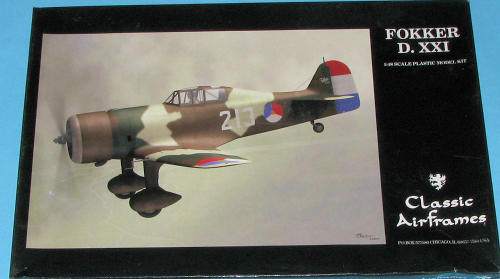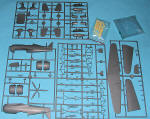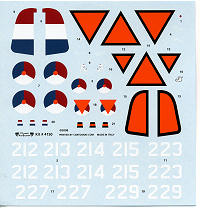
| KIT #: | 4150 |
| PRICE: | $48.00 MSRP - $38.35 from GreatModels |
| DECALS: | four options |
| REVIEWER: | Scott Van Aken |
| NOTES: | Short run with resin and photo etch parts |

| HISTORY |
The Luchtvaartafdeeling (Dutch Army Air Force before World War II) placed an order of 36 aircraft, which were all delivered in time to participate in the war against the Germans in May 1940. The Fokker D.XXI, although much slower and more lightly armed than the Bf 109, performed surprisingly well in dogfights, due to its maneuverability. Nonetheless, the numerical disparity of the Luchtvaartafdeeling compared to the Luftwaffe resulted in the destruction of most Dutch Fokker D.XXI fighters during the campaign. Some were captured during and after May 15th, but their fates, apart from their capture, are unknown.
The Fokker D.XXI performed better and for much longer in the Finnish Air Force, which had acquired a number of licence-built fighters prior to the start of the Winter War. Against the aircraft of the Soviet Air Force, the Fokker was more evenly matched, and its rugged design with a radial engine and fixed undercarriage made it very suitable for Finnish conditions. Later in the war, as newer models of Soviet fighters appeared, the Fokker D.XXI was underpowered and too lightly armed (with only four .30 caliber machine guns) to compete. Plans to arm the Fokkers with 20 mm cannons were dropped and only one fighter was armed as such (two 20 mm cannons and two .30 machine guns). Another fighter was equipped with retractable landing gear, but due to bad performance, wasn't continued in the series. During the Continuation War (1941-44) the Finnish State Aircraft Factory (Valtion Lentokonetehdas, VL) also built some fifty D.XXIs with the Swedish-built Pratt & Whitney R-1535 Twin Wasp Junior as the Bristol Mercury was in short supply. These can be identified by their longer cockpit glazing, smooth cowl, and large ventral air intake under the cowl.
Several Finnish Air Force pilots became fighter aces on Fokker D.XXI, top scoring Fokker ace being Jorma Sarvanto with 12 5/6 victories. Many other aces scored at least one victory on Fokker. The highest scoring airframe is FK-110, with 10 victories, which survived the war, and is on display at Central Finland Aviation Museum.
| THE KIT |
 If
I'm not wrong, this aircraft was Classic Airframes' first short run kit. Back
then, the moldings were cruder, there was a LOT more photo etch and all the
clear bits were vacuformed plastic. Still, it was a very popular kit and after
production ceased, there was a heavy secondary market for these. That kit sold
for the nearly unheard of price of about $25, yet modelers snapped them up.
If
I'm not wrong, this aircraft was Classic Airframes' first short run kit. Back
then, the moldings were cruder, there was a LOT more photo etch and all the
clear bits were vacuformed plastic. Still, it was a very popular kit and after
production ceased, there was a heavy secondary market for these. That kit sold
for the nearly unheard of price of about $25, yet modelers snapped them up.

| CONCLUSIONS |
So there you have it. Seems like we have come back to square one in regards to this kit. By the look of things, this will be a much better build as the technology has improved so much over the years. The D.XXI has been a favorite of many and I'm sure this one will be well received.
| REFERENCES |
January 2009
You can find this and other fine kits and accessories at
GreatModels If you would like your product reviewed fairly and quickly, please
contact
me or see other details in the
Note to
Contributors.